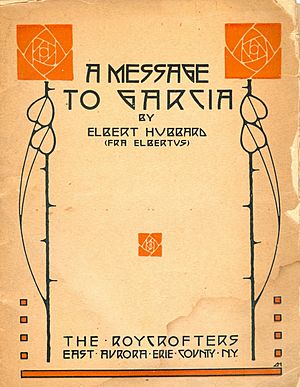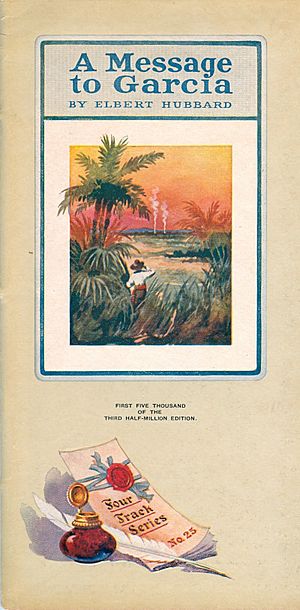A Message to Garcia facts for kids
 |
|
| Author | Elbert Hubbard |
|---|---|
| Country | United States |
| Language | English |
| Genre | Literature |
| Publisher | The Roycrofters |
|
Publication date
|
1899 |
| Media type | Print (Hardcover, Paperback, E-Book) |
| Pages | 42 |
| ISBN | 978-1-61720-215-5 |
A Message to Garcia is a famous essay written by Elbert Hubbard in 1899. It talks about how important it is for people to take charge and do their work well. The essay uses a dramatic story about an American soldier, 1st Lt. Andrew Summers Rowan. This story happened just before the Spanish–American War.
The essay describes Rowan carrying a secret message. He had to deliver it from President William McKinley to "Gen. Calixto García". Garcia was a leader of Cuban rebels, hiding somewhere in the mountains of Cuba. No one knew exactly where he was.
Hubbard's essay praises Rowan's strong effort. It contrasts this with what he called "the inability or unwillingness to concentrate on a thing and do it" in many people. The main idea is to simply "Carry a message to Garcia!"—meaning, do your job without needing constant directions.
Contents
How the Essay Became Famous
A Message to Garcia first appeared in March 1899. It was published in a magazine called The Philistine. Elbert Hubbard wrote the entire magazine himself.
Many business leaders liked the essay. They agreed with Hubbard's thoughts about workers who were not very motivated. One of these leaders was George H. Daniels from the New York Central Railroad. He printed the essay hundreds of thousands of times. It was part of the railroad's travel pamphlets.
Hubbard's own company, Roycroft Press, also printed and sold the essay. They made it in different styles, like suede and paperback. Many groups used it as promotional material. These included Wanamaker's department store, the Boy Scouts of America, and the United States Navy. The essay also appeared in many books that offered inspiration. Today, you can easily find it online.
The Real Story Behind the Message
In Elbert Hubbard's essay, President McKinley needed to send a message to General Calixto Garcia. Hubbard wrote that someone told the President, "Rowan will find Garcia for you if anybody can."
Hubbard's story says Rowan took the letter, sealed it in a waterproof pouch, and strapped it over his heart. He then supposedly landed in Cuba by boat, disappeared into the jungle, and came out three weeks later. He had traveled through a dangerous country on foot and delivered his letter to Garcia.
However, most of Hubbard's story was not true. The only true part was that Rowan "landed... off the coast of Cuba from an open boat." President McKinley did not send Rowan. Rowan also did not deliver a letter to Garcia.
Rowan's True Mission
It was actually Major Arthur L. Wagner who sent Rowan. Wagner was the head of the Military Information Division. He wanted to send spies to Cuba and Puerto Rico to gather military information.
Rowan was chosen to join General Calixto García. Garcia was leading the rebel forces in eastern Cuba. On April 9, Rowan pretended to be a civilian. He boarded a ship in New York heading to Kingston, Jamaica. In Jamaica, he got help from the U.S. consul. He then met with the Cuban Revolutionary Junta. Some members of this group took him by boat to the coast of Cuba. They landed on April 25.
Rowan rode horseback with the rebels for eight days. They traveled through the Sierra Maestra Mountains. On May 1, Rowan met with Garcia in the city of Bayamo. Rowan's job was to keep the War Department updated. He was supposed to report on the rebels' strength, movements, and overall military situation. His orders were to stay in Cuba and send back reports.
But Rowan did not follow these orders. He told Garcia he was there to learn what Garcia needed for a possible U.S. invasion. He also said he wanted to return to the U.S. Garcia saw this as a chance to send his own staff to talk with U.S. officials. So, Garcia sent Rowan back to the U.S. just hours after he arrived.
Rowan and Garcia's staff traveled five days by horseback. They went to Manatí Bay on Cuba's north coast. From there, they took a small boat to Florida. A passing ship then took them to Nassau, and finally to Tampa. They arrived on May 13.
A Public Hero
Soon after Rowan landed in Cuba, details of his secret mission became public. An Associated Press reporter named Elmer Roberts learned about it in Jamaica. This was not what the military wanted.
However, the news reports made Rowan a popular hero, even if the story was not fully accurate. Because of this, he was not punished. Instead, he became as famous as Buffalo Bill. Major General Nelson A. Miles praised him. Rowan was even temporarily promoted to lieutenant-colonel.
How Many Copies Were Printed?
Elbert Hubbard claimed that his essay was printed over forty million times by 1914. His son later said it was eighty million times. In 1926, a bill to promote Andrew Summers Rowan claimed 225 million copies were printed.
However, experts like Alice Hackett and James H Burke estimated about four million copies by 1977. Today, with digital copies, it's hard to count. But no one has proven the claim of forty million copies.
Hubbard also told a story about the essay being translated into Russian. He said the Director of Russian Railways, Prince Hilakoff, took it home and gave a copy to every railroad employee. He also claimed that during the Russo-Japanese War, every Russian soldier got a copy. Then, the Japanese found it on Russian prisoners, translated it, and the Mikado ordered it given to every Japanese government employee.
These stories are not true. Prince Hilakoff was in the U.S. before the essay was even written. Also, no copies of these claimed Russian or Japanese government pamphlets have ever been found. While Hubbard claimed the essay was translated into "all written languages," this has not been shown. However, it can be found in many modern translations today.
In Popular Culture
The phrase "to carry a message to Garcia" became a common saying. It meant taking initiative and doing a difficult task without being told every step. Even Richard Nixon used this phrase in conversations.
The essay's idea was perfect for the Boy Scouts of America. A 1917 Boy Scouts Yearbook said that if you give a Boy Scout a "Message to Garcia," you know it will be delivered. This is true even if mountains, deserts, or seas are in the way.
There have been two movies based on the essay, both called A Message to Garcia.
- The first was a silent movie made in 1916 by Thomas A. Edison, Inc..
- The second film was made in 1936 by Twentieth Century Fox. It starred John Boles as Andrew Rowan.
The 1965 book Up the Down Staircase by Bel Kaufman also has a chapter titled "A Message to Garcia."
See Also
 In Spanish: Un mensaje a García para niños
In Spanish: Un mensaje a García para niños


